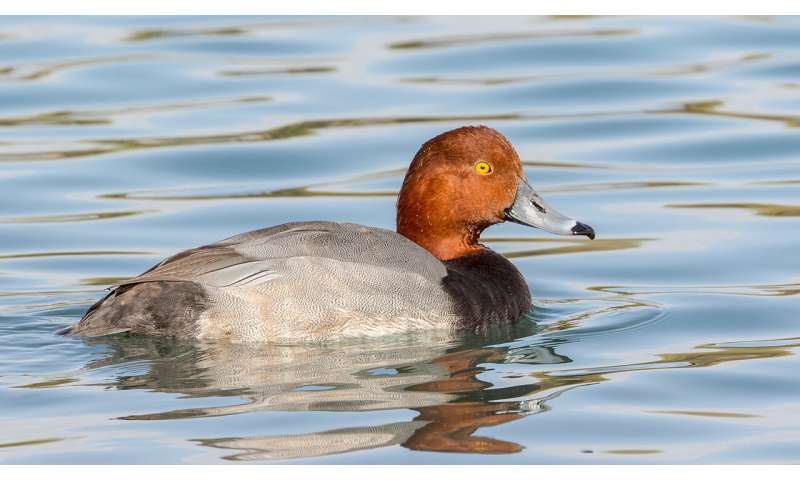This article has been reviewed according to Science X's editorial process and policies. Editors have highlighted the following attributes while ensuring the content's credibility:
fact-checked
trusted source
proofread
Forever chemicals reach extraordinary levels in wildlife at Holloman Air Force Base

A team of researchers from The University of New Mexico's Museum of Southwestern Biology (MSB) have reported unexpectedly high levels of chemical contamination in wild birds and mammals at Holloman Air Force Base, near Alamogordo, N.M. in new research published in Environmental Research.
The research found that animals were heavily contaminated with several harmful compounds known as "forever chemicals," or per and poly-fluoroalkyl substances (PFAS). Even low concentrations of PFAS are known to cause cancer and developmental, reproductive, immune system, and endocrine problems in animals and people.
Although PFAS have been found in various wildlife worldwide, the new findings are unprecedented for exceptionally high concentrations across numerous species. Across 23 species of birds and mammals, PFAS concentrations averaged in the tens of thousands of parts per billion. To put this in perspective, the research team pointed out that thousands of dairy cattle in Clovis, N.M., recently had to be destroyed because their milk was contaminated at less than six parts per billion.
The study focused on the area around Holloman Lake, situated between Holloman Air Force Base and White Sands National Park, in the middle of the vast, dry Tularosa basin. The lake is part of a system of waste-water catchment ponds that the Air Force created.
"Because these large wetlands are the only ones in the region, they are immensely attractive to wildlife," said MSB Director and Professor of Biology Christopher Witt, and the lead author of the study.
"Holloman is one of the three most important wetlands in New Mexico for migratory waterbirds —over 100 species and tens of thousands of individuals use these habitats annually," Witt explained. "The wetlands are also heavily used by people for recreation and hunting."
The leading cause of contamination is thought to be the fire-fighting foam that was deployed over decades by the U.S. Air Force. The foam contained a mix of toxic PFAS that have since been phased out of manufacturing. Starting around 1970, the foam was widely used for training exercises at military installations. At Holloman A.F.B., runoff flowed into the waste-water catchments.
-

The Snowy Plover (Charadrius alexandrinus nivosus) is a rare species that breeds along the margins of Holloman Lake. Credit: Michael J. Andersen -

Male Redhead (Aythya americana), one of the duck species subject to PFAS contamination at Holloman Lake. Credit: Michael J. Andersen
"PFAS compounds are highly stable, so they just accumulated there in the water and mud," said Research Associate in the MSB Division of Mammals and Research Professor in the Department of Biology Jean-Luc Cartron, a co-author on the study. "These substances also bind to proteins, so they were easily taken up by living creatures and then passed up the food chain."
To understand PFAS movement through the food web at Holloman Lake, the research team conducted over 2000 measurements, testing for the various compounds in different species and tissue types. The team focused on aquatic birds because of their heavy exposure to contaminated water and because they are sought after by hunters.
A set of desert rodents from the surrounding area was also tested because they would not be directly exposed to the water; thus, their potential contamination would reveal other avenues of PFAS movement.
Remarkably, the team found that both aquatic and terrestrial species tended to be heavily contaminated.
"There were differences among species in how much of each PFAS they contained, reflecting differences in their habitats, diet, and physiology," said Chauncey Gadek, co-author on the study and Ph.D. student in the Department of Biology. "Ultimately, these differences illustrate the different paths by which PFAS can move through ecosystems and accumulate in various species, including people."
Working with the natural history collections at the MSB provided several advantages for this study. For example, the team was able to screen for PFAS in rodent specimens collected on Holloman Air Force Base in 1994 for a different research project. Tissues from those 1994 rodents had been perfectly preserved in the MSB Division of Genomic Resources, a world-class cryo-collections facility.

The history of fire-fighting foam suggests that the Holloman A.F.B. wetlands should have been contaminated with PFAS since the 1970s. As predicted, the 1994 specimens were rife with PFAS.
"In fact, the single most contaminated individual in the study was a 1994 specimen of a white-footed mouse," said co-author and MSB Senior Collection Manager in the Division of Mammals Jon Dunnum. "These findings demonstrate that contamination of wild animal tissues at Holloman has been extraordinarily high for at least three decades."
"Natural history collections are uniquely positioned to document the status or health of populations over space and time," said Distinguished Professor of Biology Joseph Cook, co-author of the study and Curator of Mammals at the MSB. "This study exemplifies how museum collections are providing critical insights into our changing planet as specimens are used to address diverse environmental and societal problems."
Hunting is popular at Holloman Lake as well as in the surrounding region. The new study showed that consuming wild game from the site could be harmful. Based on the average PFAS concentrations found in duck meat from the site, it would never be advisable to consume as much as a single gram (for comparison, a U.S. penny weighs 2.5 grams).
More research will be needed to understand the degree of risk that PFAS pollution poses to human health in the region. For example, exposure could occur by breathing wind-blown particles or by consuming the meat of the oryx or free-ranging cattle that also frequent the area.
The isolated desert wetlands that form an oasis for animals also acted as a trap for the accumulation of contaminants.
"Creating this productive wetland ecosystem was great for biodiversity, so it is critical that we continue conducting research that may help guide its recovery," said Witt.
More information: Christopher C. Witt et al, Extraordinary levels of per- and polyfluoroalkyl substances (PFAS) in vertebrate animals at a New Mexico desert oasis: Multiple pathways for wildlife and human exposure, Environmental Research (2024). DOI: 10.1016/j.envres.2024.118229
Provided by University of New Mexico





















